The Internet of Things (IoT) has given us various technologies that have impressed the world, particularly business owners. It has driven significant achievements in healthcare, manufacturing, devices and industry.
Here are some of the most innovative examples of how businesses are using the Internet of Things technology to drive their business further.
Networking giant Cisco predicts that the opportunity represented by the Internet of Things will be worth $14.4 trillion.
1. Healthcare
Internet of Things applications are transforming healthcare by facilitating treatments and improving overall care in a variety of ways.
Connected contact lenses are one of the most interesting examples of IoT in the healthcare industry. These contacts have built-in sensors that can analyse tears and provide the primary care physician with information on a patient’s health, such as the glucose level in a diabetic patient.
Activity trackers are another innovative example of IoT in healthcare. Equipped with sensors, activity trackers monitor the primary changes in a patient’s body, offering data on appetite, blood pressure, heart rate, fatigue and more so that doctors always have the most current information. This can be used to develop targeted care plans and help patients improve their quality of life.
2. Manufacturing
IoT in manufacturing helps workers receive the most accurate data for analytics, improve product quality and reap the benefits of machine learning to enhance key processes.
Digital twin technology is a unique example, as it uses digital copies of physical objects to allow experimentation and predictions about the object’s operation. This application can be used to simulate the lifespan of machinery, test update protocols, and forecast potential problems.
Automated self-healing systems are also prominent in manufacturing. This technology allows physical machinery to solve its own problems without human intervention. Like digital twins, self-healing systems help manufacturers predict future equipment problems and develop better products.
3. Industrial
The industrial applications for IoT are among the most revolutionary. Automation, enhanced analytics and networking provide more modern approaches to existing processes.
IoT technologies can provide machine operators with an instant, comprehensive view of the key indicators of the health of heavy equipment, such as failing parts and fuel levels. The repair information is sent by the augmented reality app, which reduces the time spent troubleshooting and correcting malfunctions.
4. Devices
One of the most accessible and fascinating applications of IoT is the wealth of smart devices on the market. These include everything from phones and watches to safety systems and thermostats, all of which offer unique benefits to improve the quality of life.
In the realm of safety and security, the smart lock is a notable example. This application has the potential to replace keys and locks by allowing only certain people access to homes or buildings. The system is controlled by a smartphone, but a password on a keypad is available to open the door.
Smart mirrors are another example with unique capabilities. A smart mirror can display the time, date, weather conditions and other notifications from your smartphone, as well as offer a voice function for controls.
Centrica, a British multinational energy and services company, can react quickly and flexibly to changes and is strongly positioned to meet the needs of our customers, now and in the future.
5. Retail and supply chain management
Retail was ahead of the curve in adopting and implementing smart technology, and it continues to realise more applications for IoT in the workplace.
With IoT, retailers have full control over supply chains without human intervention, so owners can keep accurate inventory records, oversee staff members, and control logistical and merchandising expenses.
Another example of IoT in retail is an anti-theft smart tag that’s attached to a product and released only after payment is made.
How to get started with IoT
Though these are early examples, they show how the Internet of Things’ innovative technology is revolutionising a wide range of industries, and we’re only scratching the surface of this technology’s capabilities. When combined with other emerging technologies, such as artificial intelligence, augmented reality, virtual reality and blockchain, businesses have the ability to unlock untapped revenue, gain competitive advantages and develop higher-quality products.
Learn how Salesforce IoT is the glue that connects the world of connected devices with the world of CRM.








